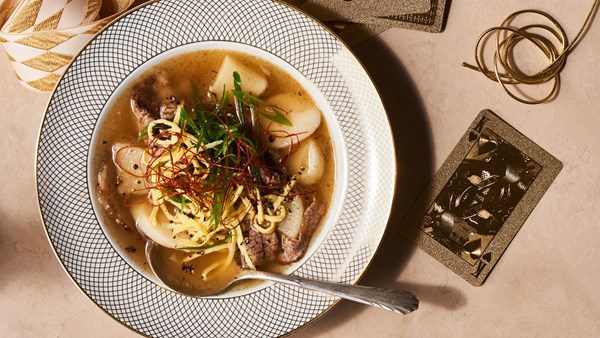Welcome the Year of the Dragon
February 10, 2024 by DarcieToday marks the beginning of a very special time for the Chinese and several other cultures, as it is the beginning of the lunar new year, which is called Tet in Vietnam, Tsagaan Sar in Mongolia, Losar in Tibet, and Seollal in Korea. This holiday, celebrated by 20% of the world’s population, is honored differently in various countries, but food features prominently in all celebrations. Each of the foods traditionally eaten during this holiday has a meaning behind it.

The most significant dish for the Korean New Year is Tteokguk, rice cake soup. It is usually made with beef or anchovy broth, beef chunks, thinly sliced rice cake, with egg or al-gomyeong (a type of omelette) whisked in to finish. This dish is believed to bring longevity, good health and fortune. If you aren’t familiar with Korean rice cakes, head over to Saveur, which dives into the world of tteok, providing a guide to the different sizes, shapes, and cooking preparations.
In Tibet, Losar is celebrated with momo, a type of dumpling. These are packed with minced meat and are filled with juice, which necessitates a thicker wrapper to contain the liquid. People in the northern part of China celebrate the new year with dumplings, while in the South they are more likely to feast on spring rolls or tangyuan. For sweets, Nian gao, also known as “rice cake” or “New Year cake” in English, are a must for Chinese New Year. Many of the traditional New Year’s foods are symbols of good luck and prosperity in the coming year.
Categories
- All Posts (6940)
- Antipasto (2135)
- Author Articles (247)
- Book News (935)
- Cookbook Giveaways (983)
- Cookbook Lovers (257)
- Cooking Tips (109)
- Culinary News (299)
- Food Biz People (552)
- Food Online (791)
- Holidays & Celebrations (272)
- New Cookbooks (149)
- Recipes (1500)
- Shelf Life With Susie (231)
- What's New on EYB (133)
Archives
Latest Comments
- Atroyer7 on Danube Cookbook Review and Giveaway
- demomcook on What foods do you look forward to the most for each season?
- demomcook on Danube Cookbook Review and Giveaway
- Darcie on How cookbooks can help build resilience
- mholson3 on Danube Cookbook Review and Giveaway
- Rinshin on How cookbooks can help build resilience
- sarahawker on Danube Cookbook Review and Giveaway
- Sand9 on Danube Cookbook Review and Giveaway
- hankintoby29 on Heritage Cookies of the Mediterranean World – Cookbook Giveaway
- WBB613 on Feasts of Good Fortune Cookbook Giveaway